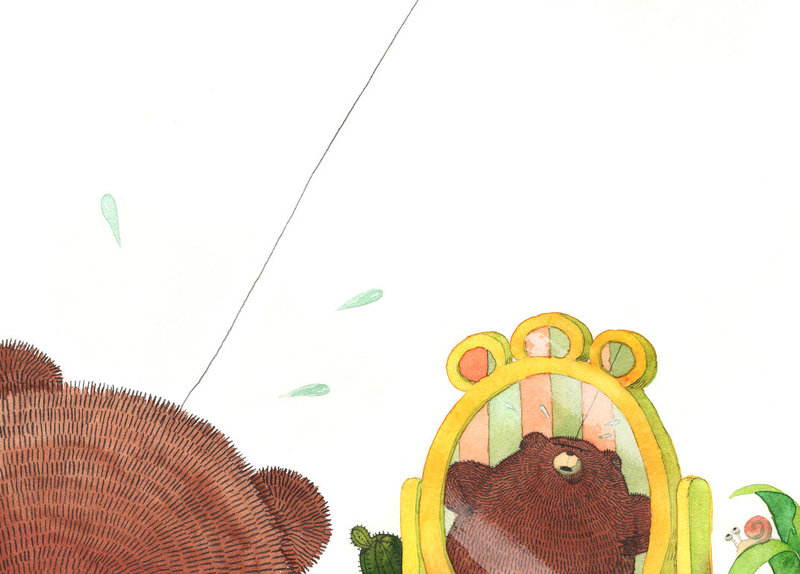ಮಿಂಗ್ ಮಿಂಗ್ ನ ಟೊಂಯ್ ಟೊಂಯ್ ಮತ್ತು ನಗುವಿನ ಗುಟ್ಟು
Posted by Remya Padmadas on December 02, 2019Pratham Books' in-house editor, Hema D Khurshapur, writes exclusively about translations and how they end up giving the feel of the original story, if given a fresh approach. In this blog post, she writes about C.P. Ravikumar's translation of Ming-Ming, Fat Little Bear’s translation into Kannada and the psychology behind laughter.
ಮನುಷ್ಯರ ಮಕ್ಕಳಿಗಷ್ಟೇ ತುಂಟತನ ಸೀಮಿತವೇ? ಪ್ರಾಣಿಗಳ ಮಕ್ಕಳೂ ತುಂಟತನ ಮಾಡಬಹುದಲ್ಲವೇ? ಅದ ರಲ್ಲೂ ಮುದ್ದಿಗೆ ಹೆಸರಾದ ಕರಡಿ ಮರಿಗಳು ತುಂಟತನ ಮಾಡಿದರೆ ಹೇಗಿರುತ್ತದೆ. ಅದೇ ಈ ಪದ್ಯದಲ್ಲಿ ಮೂಡಿ ಬಂದಿರುವುದು. ಕೂದಲಿಗೆ ಉದಾಹರಣೆ ಕೊಡುವಾಗ ನಾವೆಲ್ಲ ಒಂದಲ್ಲ ಒಂದು ಸಲ ಬಳಸಿರುವ ವಾಕ್ಯ, ಅಲ್ಲಿ ನೋಡು ಅವನ ಅಥವಾ ಅವಳ ಕೂದಲು ಕರಡಿ ಕೂದಲಂತೆ ಎನ್ನುವುದು.

Illustrations from the book, Ming-Ming, Fat Little Bear, by Vishnu M Nair
ಕನ್ನಡದಲ್ಲಿ ಕರಡಿ ಮತ್ತು ಕರಡಿ ಮರಿ ಕುರಿತಾಗಿ ಬಹುತೇಕ ಮಕ್ಕಳು ಕೇಳಿರಬಹುದಾದ ಒಂದು ಕವನ, ಒಂದು ಕತೆ ಇದೆ. ಕವನ ಅಂದ್ರೆ ಅದು ಬೇಂದ್ರೆಯವರ ‘ಕರಡಿ ಕುಣಿತ’, ಕತೆ ‘ಜಾಂಬವಂತ’ ಕರಡಿಯ ಕತೆ. ‘ಕರಡಿ ಕುಣಿತ’ ಕವನ ಕರಡಿ ಆಡಿಸುವವನಿಂದ ಶುರುವಾಗಿ, ಮಕ್ಕಳು ಕರಡಿಯನ್ನು ಮುಟ್ಟಿ ನೋಡುವ ಪ್ರಕ್ರಿಯೆ ಮುಗಿದು, ಕರಡಿಯ ಕೂದೆಲೆಳೆ ಮಕ್ಕಳಿಗೆ ದೃಷ್ಟಿಯಾಗದಂತೆ ತಡೆಯುತ್ತದೆ ಎನ್ನುವ ನಂಬಿಕಯೊಂದಿಗೆ ಮುಗಿಯುತ್ತದೆ. ‘ಜಾಂಬವಂತ’ ಕರಡಿಯ ಕತೆಯಲ್ಲಿ ಬರುವ ಕರಡಿ ಮಾತ್ರ ಜೇನು, ಹಲಸಿನ ಹಣ್ಣು ತಿನ್ನುವ ಮುದ್ದು, ಮುದ್ದು ಪ್ರಾಣಿಯಾಗಿ ಮಕ್ಕಳನ್ನು ಸೆಳೆಯುತ್ತದೆ.
ಆದರೆ ಈ ಮಿಂಗ್ ಮಿಂಗ್ ಎಂಬ ಕರಡಿ ಮರಿ, ಇನ್ನೂ ಮುದ್ದು ಮುದ್ದು. ಒಂದು ದಿನ ಬೆಳಗಾಗಿ ಎದ್ದು ನೋಡಿದರೆ ಮರಿಯ ತಲೆಯ, ಮೈಮೇಲಿನ ಕೂದಲೆಲ್ಲ ನೆಟ್ಟಗೆ ನಿಂತಿವೆ. ಅದಕ್ಕೆ ಏನು ಮಾಡಬೇಕೋ ತೋಚುತ್ತಿಲ್ಲ. ಯಥಾ ಪ್ರಕಾರ ಅಪ್ಪ-ಅಮ್ಮ, ಅಣ್ಣ-ಅಕ್ಕ, ದೊಡ್ಡಪ್ಪ-ಚಿಕ್ಕಪ್ಪ ಎಲ್ಲರೂ ಒಂದೊಂದು ಸಲಹೆ ಕೊಡುವವರೇ. ಎಲ್ಲರ ಮಾತು ಕೇಳಿ ತಲೆ ಚಿಟ್ಟು ಹಿಡಿದು ಮಲಗುವ ಕರಡಿ ಮರಿಯ ಕೂದಲು ಮತ್ತೊಂದು ಬೆಳಗ್ಗೆ ಎದ್ದು ನೋಡುತ್ತಲೇ ಮೊದಲಿನಂತಾಗಿ ಬಿಟ್ಟಿರುತ್ತದೆ.
ಇಂಗ್ಲಿಷ್ ನಲ್ಲಿ ಎಲ್ಲವೂ ಸರಿ ಎನ್ನಿಸಿಯೇಬಹುದಾದ ಅಥವಾ ಹಾಗೆಂದು ನಾವು ಭಾವಿಸುವ ವಾಕ್ಯ ರಚನೆಗಳನ್ನು ಕನ್ನಡಕ್ಕೆ ತರುವಾಗ ಎದುರಾಗುವ ಸಮಸ್ಯೆಗಳು ಒಂದೆರಡೆಲ್ಲ. ಅದು ಅನುವಾದ ಪ್ರಕ್ರಿಯೆಯಲ್ಲಿ ತೊಡಗಿ ಕೊಂಡವರಿಗೆಲ್ಲ ಗೊತ್ತಿರುವ ವಿಷಯ. ಈ ಕವನವನ್ನು ಕೂಡ ಇಂಗ್ಲಿಷಿನಲ್ಲಿ ಓದುವಾಗ ಚೆಂದ ಎನಿಸುವ ಪ್ರಾಸಗಳನ್ನು ಕನ್ನಡಕ್ಕೆ ತರುವುದು ನಿಜಕ್ಕೂ ಸ್ವಲ್ಪ ಕಷ್ಟದ ಕೆಲಸ. ಕವನ ವನ್ನು ಟ್ರಾನ್ಸ್ ಫಾರ್ಮ್ ಮಾಡದೇ ಅನುವಾದದಲ್ಲಿ ಸ್ವಲ್ಪ ಮಟ್ಟಿನ ಸ್ವಾತಂತ್ರ್ಯ ವಹಿಸಿ ಒಂದೆರೆಡು ವಾಕ್ಯ, ಒಂದೆರೆಡು ಸಾಲುಗಳನ್ನು ಸೇರಿಸುವ ಮೂಲಕ ಕವನವನ್ನ ಕನ್ನಡದ್ದೇ ಆಗಿಸಿದ್ದು ಅನುವಾದದ ಮಟ್ಟಿಗೆ ಒಳ್ಳೆಯ ಪ್ರಯತ್ನ. ಓದುತ್ತಿದ್ದರೆ ನಗುವನ್ನು ತಡೆಯಲು ಆಗದ ಕೆಲಸ. ಇಂತಹ ಒಳ್ಳೆ ಪ್ರಯತ್ನಕ್ಕಾಗಿ ಅನುವಾದಕ ಸಿ.ಪಿ.ರವಿಕುಮಾರ್ ಅವರಿಗೆ ಅಭಿನಂದನೆಗಳು.
ಬರೀ ಮಿಂಗ್ ಮಿಂಗ್ ಎಂಬ ಮುದ್ದು ಕರಡಿ ಮರಿ ಪದ್ಯ ಕನ್ನಡಕ್ಕೆ ಅನುವಾದಗೊಂಡ ಪ್ರಕ್ರಿಯೆ ಚೆಂದವಾದದ್ದು ಅಂತ ಓದಿದರೆ ಸಾಕೇ... ಓದುವಾಗ ಬರುವ ನಗು, ಹುಟ್ಟುವುದು ಹೇಗೆ ಎನ್ನುವುದರ ಬಗ್ಗೆಯೂ ಒಂದು ಕುತೂಹಲವಾದ ವಿಷಯವಿದೆ.

Illustrations from the book, Ming-Ming, Fat Little Bear, by Vishnu M Nair
ನಗು ಹುಟ್ಟುವುದು ಹೇಗೆ?
ಪ್ರಶ್ನೆಗೆ ಉತ್ತರ ತುಂಬಾ ಸರಳ. ಒಬ್ಬ ಹಾಸ್ಯನಟನನ್ನು ನೋಡಿದರೆ ಸಾಕು, ನಮಗೆ ತಿಳಿಯುತ್ತದೆ! ಆದರೆ ನಗೆ ಸಂಕೀರ್ಣ ವಿಷಯ. ನಾವು ಸಹಜವಾಗಿ ಭಾವನೆಗಳನ್ನು ಅಭಿವ್ಯಕ್ತಿಸುತ್ತೇವೆ. ನಗು ಮನುಷ್ಯರ ನಡುವೆ ಮಾತ್ರ ಕಂಡು ಬರುತ್ತದೆ. ಆದರೆ, ಮನಃಶಾಸ್ತ್ರಜ್ಞರು ನಗುವಿನ ಬಗ್ಗೆ ಎರಡು ಮೂಲಭೂತ ಪ್ರಶ್ನೆಗಳನ್ನು ಇನ್ನೂ ಅಧ್ಯಯನ ಮಾಡುತ್ತಿದ್ದಾರೆ. ಒಂದು, ಜನರನ್ನು ನಗುವಂತೆ ಮಾಡುವುದು ಯಾವುದು? ಎರಡು, ನಗುವಿನ ಉದ್ದೇಶವೇನು? ಜನರು ನಗುವಂತೆ ಮಾಡುವ ಅಂಶ ಯಾವುದು ಅಥವಾ ಜನ ಯಾವುದನ್ನು ತಮಾಷೆ ಎಂದು ಪರಿಗಣಿಸುತ್ತಾರೆ ಎಂದು. ಉತ್ತರ ಹುಡುಕುತ್ತಾ, ಆಲೋಚಿಸುತ್ತಾ ಹೋದರೆ ನಾವು ಮನಃಶಾಸ್ತ್ರಜ್ಞ ಅಥವಾ ತತ್ವಜ್ಞಾನಿಗಳಾಗಿ ಬಿಡುತ್ತೇವೋ ಏನೋ?
ಜನರ ಕೆಲವು ಎಡವಟ್ಟು, ವ್ಯಕ್ತಿಯ ದೌರ್ಬಲ್ಯ ಅಥವಾ ಕುಂದು-ಕೊರತೆ, ಕಾಳಜಿಯ ಸಂದರ್ಭಗಳಲ್ಲೂ ಜನರು ನಗುತ್ತಾರೆ. ನಗುವಿನ ಬಗೆಗಿನ ಮತ್ತೊಂದು ವಿವರಣೆ ಎಂದರೆ, ಇದ್ದಕ್ಕಿದ್ದಂತೆ ನೋಡಿದ ಕೆಲವು ದೃಶ್ಯಗಳು ನಗು ಹುಟ್ಟಿಸುತ್ತವೆ. ಅವು ಸಹಜ ಸಂಗತಿಗಳೇ ಇರಬಹುದು ಅಥವಾ ವ್ಯಕ್ತಿಗಳು ಜತೆಗಿದ್ದಾಗ ಕಣ್ಣ ಮುಂದೆ ನಡೆಯುವ ವಿಷಯಗಳಿರಬಹುದು. ಎಲ್ಲ ರೀತಿಯ ನಗುವಿಗೂ ಈ ಸಿದ್ಧಾಂತ ಅನ್ವಯವಾಗುವುದಿಲ್ಲ. ಕಾಮಿಕ್ ನೋಡಿದಾಗ ಉಕ್ಕುವ ನಗುವೇ ಬೇರೆ, ವಿನೋದ ಸಾಹಿತ್ಯ ಅಥವಾ ಘಟನೆ ನೋಡಿದಾಗ ಉಂಟಾಗುವ ನಗುವೇ ಬೇರೆ. ದೈಹಿಕವಾಗಿ ನಗುವಿನ ಅಂಶವನ್ನು ನೋಡಿದರೆ, ನಗು ಒಳ್ಳೆಯದು. ಇದು ನಮ್ಮ ಶ್ವಾಸಕೋಶಕ್ಕೆ ಮತ್ತು ದೇಹಕ್ಕೆ ಬೇಕಾದ ಹೆಚ್ಚುವರಿ ಶಕ್ತಿಯನ್ನು ಒದಗಿಸುತ್ತದೆ. ನಾವು ಸಾಮಾನ್ಯವಾಗಿ ಹೆಚ್ಚು ನಗುವುದು ಒಂದು ಗುಂಪಿನಲ್ಲಿದ್ದಾಗ. ಈ ಸಿದ್ಧಾಂತದ ಪ್ರಕಾರ ಜನರ ನಗುವನ್ನು ನೋಡಿ ಅವರ ವರ್ತನೆಯ ಟಿಪ್ಪಣಿ ಮಾಡಬಹುದಂತೆ!!
Do leave your thoughts in the comments section below. You can also reach out to us through our social media channels: Facebook, Twitter and Instagram.
Be the first to comment.On translating children's books: A Google Serve volunteer's story
Posted by Remya Padmadas on January 06, 2020Karthigeyan Sivaraj is a Google Serve campaign volunteer who has worked with StoryWeaver to help translate several storybooks into Tamil, including I Can Climb! and My Best Friend.
In this Q&A, Karthigeyan shares his experience about translating on StoryWeaver, his insight into the translation process, and his love for children's literature.

Q: Do tell us a little bit about yourself, your interests, your work
I'm a Googler by profession and by practice, and I'm proud of that! At work, being a Googler means respecting my colleagues and welcoming their opinions and ideas, howsoever different they may be to my own, and keeping things necessarily simple to my stakeholders, and I attempt to do the same outside the walls of my office as well. Having learned how to analyze data on the job, I brand myself as a data story-teller - i.e., processing data and presenting meaningful information in a way that pushes the audience to take the desired action. The interesting aspect of my job is that it allows me to improve the existing processes through imaginative ways and take ownership of some of the workflows in my organisation, thereby ensuring candidates joining Google have a lasting positive impression about their onboarding experience.
Q: Do you remember the first time you heard about StoryWeaver? What are your thoughts about the platform?
Of course, it's quite vivid in my memory the first time I heard about StoryWeaver. The concept of weaving children's stories is quite dear to my heart, and it's really gladdening to see the team working behind crafting stories as well as making them available in multiple different languages for the young audience to read and relish. I personally nurtured a similar idea a few years ago when I was an avid blogger but didn't have the imaginative power nor the enterprising capabilities to venture into this domain - I was really happy to find the StoryWeaver team doing some marvellous work in this field. Kudos to all!
Q: What was your experience of the GServe campaign, and translating books with fellow Google volunteers?
It's always a very humbling experience to take part in any GServe campaign, no matter what the cause that's being championed. The StoryWeaver campaign was very well thought through in many ways - for one, it didn't require us to sacrifice the luxury of our desks and we could contribute while at work or on the move. It was also so much fluid socializing with fellow Googlers who were taking up similar translation work. Overall, it was a rewarding experience to be able to contribute our might in little ways possible to make a huge change!
Q: We are so glad that you came on board as a commissioned translator even after the GServe campaign! What prompted you to stay in touch?
As I had mentioned previously, contributing to children's literature was always dear to me, and when I got to know about StoryWeaver's mission and their robust infrastructure, I felt relieved knowing that I didn't have to worry too much about the modus operandi, but rather focus on the work itself. With a major piece of work shouldered by the StoryWeaver team, I wanted to work with the team even after the GServe campaign, so that I could do what I like to do - writing, crafting and translating.
Q: What was your experience of being a commissioned translator? Did you pick up any new tips and techniques?
A lot I must say! One very important technique I adopted pretty early on was that I realized that translating the original work into the language of my preference required knowing the cultural nuances deeply. For instance, while translating a story from English targeting the Hindi speaking audience and translating it into Tamil would mean we will have to take into account the various cultural aspects such as the equivalent idioms used in the region. Internalizing all these cultural & regional nuances in the local language while translating is imperative if the audience has to relate to the stories. Else, they wouldn't 'stick'!
Q: How tricky is it to translate stories to Tamil? Are there any phrases that you particularly spent time on because they were difficult to translate?
Tamil, for all its richness, is a very unique language in that there are several different dialects in use across the Tamil diaspora. It becomes even trickier when you realize that the written form of the language is very different to the conversational style, and even the conversational style assumes a different shade when it comes to young audiences. Stories will have to be narrated to children in a style that's neither too formal nor too conversational and we should be ready to use a few English words that are in daily use, so they can relate to them. Also, unfortunately, tools such as Google Translate provide very literal translations of phrases which is sometimes very challenging even to the mature audience, hence you have to take a judgement call based on your own intuition and observation. I bet this is true for many Indic languages!
Q: What has been your favourite book to translate on StoryWeaver?
That's a tough one! Each of the books takes you down memory lane and makes you relive your childhood :) Be it Rani's First Day at School or the restless lad who couldn't wait to open this birthday gifts the next day or the fearless little girl - each provides a glimpse of your own childhood. For the sake of picking one, I would go for I Can Climb! which is packed with a lot of positive self-talk for young kids who are taking baby steps as they encounter different activities for the very first time in their lives.

Q: What are some of your favourite books from childhood? Is there any memorable reading moment that you would like to share?
I relished reading across different genres in both English and Tamil. In Tamil literature, especially that was taught to us in school, all messages were delivered in a cryptic fashion replete with metaphors and similes. That allowed for deep learning, situational paraphrasing and lateral thinking. For that very same reason, I preferred the works of John Milton, Rudyard Kipling & John Keats in English and innumerable poets in Tamil.
As a kid, I was an avid read of Tinkle Kids' magazines, and I used to eagerly await the next monthly edition. I am really glad to see that same level of curiosity now possessed by my niece. It seems the magazine hasn't lost its attractiveness to date!
Q: The translations you have contributed to our platform have been read over 1800 times - thank you! How has your StoryWeaver journey been? What is one big takeaway from this experience?
The biggest takeaway for me has been that we shouldn't shy away from walking in the little shoes of our young audience to truly understand what holds their curiosity and interest. Many a time, we - adult learners - tend to wear our own caps, and view children's literature in a rather lop-sided manner. However, we should be ready to speak the language of the kids (sometimes even practise prattling), simplify the language (without over-simplifying at the cost of losing the essence) to suit them and be more imaginative (what helped me to feel the pulse of the audience was to subject my work to, what I like to call, the 'niece'-test - i.e., talking to my nieces and having them vet some of my initial works)
Do leave your thoughts in the comments section below. You can also reach out to us through our social media channels: Facebook, Twitter and Instagram.
Be the first to comment.